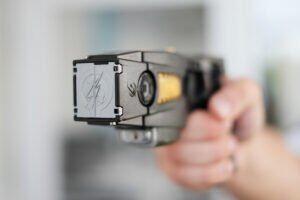Table of Contents
- Understanding California’s Legal Definition of Stun Guns and Tasers
- Permitted Ownership Criteria and Age Restrictions in California
- Detailed Guidelines on Legal Usage and Self-Defense Protections
- Practical Recommendations for Responsible Stun Gun Handling and Compliance
- In Retrospect
Understanding California’s Legal Definition of Stun Guns and Tasers
California’s legal framework classifies stun guns and Tasers under specific terms that emphasize their operational differences and intended uses. According to state law, stun guns are typically defined as handheld devices designed to deliver a high-voltage, low-current shock, incapacitating an attacker temporarily through muscle disruption. In contrast, Tasers are often recognized as devices that deploy electrically charged darts attached by wires, allowing for a short-range attack without direct contact. This distinction is pivotal in regulations, impacting how each device is categorized and regulated within the state.
The law also outlines which models and functionalities qualify under these definitions, often influencing restrictions on sales and possession. Key legal points include:
- Restriction on electrical intensity – ensuring devices meet specific voltage and current criteria to prevent lethality.
- Permitted uses – limits on self-defense situations versus professional use by law enforcement.
- Age and residency requirements – mandatory conditions for ownership, including minimum age limits.
- Transportation and carrying rules – guidelines on how these devices can be carried in public spaces.
Understanding these legal nuances is essential not only for compliance but also for informed ownership and responsible use. California continuously reviews technology and legislative updates, so staying current with state regulations is highly recommended for all stun gun and Taser owners.
Permitted Ownership Criteria and Age Restrictions in California
In California, owning a stun gun is legal, but there are specific ownership criteria that consumers must meet to comply with state regulations. Primarily, individuals must be at least 18 years of age or older to purchase or possess a stun gun. This age restriction is enforced to ensure that minors are not exposed to devices intended for self-defense that carry the potential for misuse or harm. Additionally, those with certain criminal backgrounds, particularly involving violent crimes, may face limitations or prohibitions on ownership under state and federal laws.
It’s important to note that California law also outlines certain restrictions on the possession and carrying of stun guns in sensitive locations. For example, even eligible persons should avoid bringing stun guns into schools or government buildings. To stay compliant, owners should be aware of the following:
- Possession is allowed only if the device is legally purchased and not used unlawfully.
- Minors under 18 are strictly prohibited from owning or operating stun guns.
- Individuals convicted of violent felonies may be barred from owning electroshock weapons.
Detailed Guidelines on Legal Usage and Self-Defense Protections
In California, the possession and use of stun guns are regulated with specific legal boundaries designed to balance personal safety with public welfare. It is important to note that owning a stun gun is legal statewide, but carrying one in public spaces may be subject to restrictions, particularly in sensitive areas like schools, government buildings, and public transportation systems. Using a stun gun for self-defense is legally permissible only when faced with an immediate threat, and the force applied must be proportionate to the danger encountered. Always ensure your device is unobtrusive and not used in a way that could be interpreted as aggression or intimidation, as misuse can lead to serious legal consequences.
To effectively leverage self-defense protections, keep the following considerations in mind:
- Maintain clear evidence of reasonable fear or imminent harm when deploying the stun gun.
- Refrain from using the device as a tool for retaliation or in non-threatening situations.
- Understand local ordinances, as some cities may impose additional controls beyond state laws.
- Be aware that minors are legally prohibited from possessing stun guns.
- Practice responsible storage and handling to prevent accidents or unauthorized access.
Practical Recommendations for Responsible Stun Gun Handling and Compliance
To ensure both your safety and legal compliance when owning and operating a stun gun in California, it’s crucial to follow a set of practical guidelines. First and foremost, always verify that your device is purchased from a reputable seller and is designed to meet state regulations regarding voltage and design features. Store your stun gun securely and out of reach of minors to prevent accidental use or misuse. Before carrying your stun gun in public, familiarize yourself with local ordinances as some cities may impose additional restrictions. Remember, the primary purpose of a stun gun is self-defense, so its usage should be limited strictly to situations where you genuinely feel threatened.
Additionally, proper maintenance of your stun gun is essential for it to function reliably when needed. Regularly inspect the device to ensure it remains in good working condition, checking for battery life and any signs of wear. Consider taking a certified self-defense class that includes stun gun training, which can provide valuable knowledge on how to use the device responsibly and effectively. Always keep your actions within legal boundaries by avoiding use in prohibited locations such as schools or government buildings. By adopting these responsible handling practices, you help promote public safety while respecting California’s laws surrounding stun gun ownership.
In Retrospect
Understanding California’s stun gun laws is essential for anyone considering ownership or use of these self-defense tools. While the state permits stun gun possession, compliance with specific regulations ensures you stay within the legal boundaries and use these devices responsibly. Always stay informed about any updates to local statutes and consider consulting legal experts if you have questions. By being knowledgeable and cautious, you can confidently incorporate stun guns into your personal safety routine without running afoul of the law. Stay safe and stay informed!Check Our Other Blogs
- StunGun – Your Trusted Source for Stun Guns, Laws, and Self-Defense Tips
- PepperSprayLaws – Your Trusted Resource for Pepper Spray Information
- StunGunLaws – Your Trusted Guide to Stun Gun Legality and Safety





